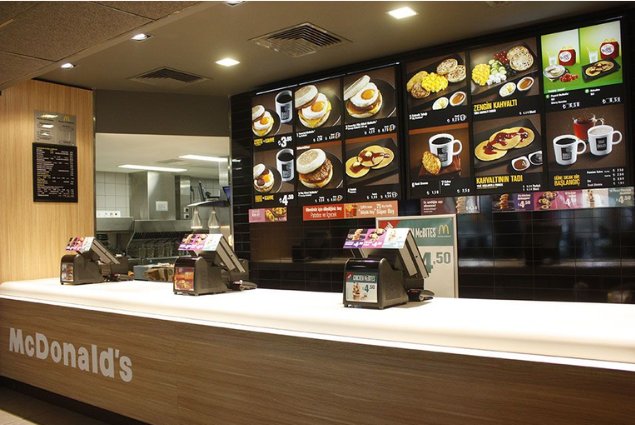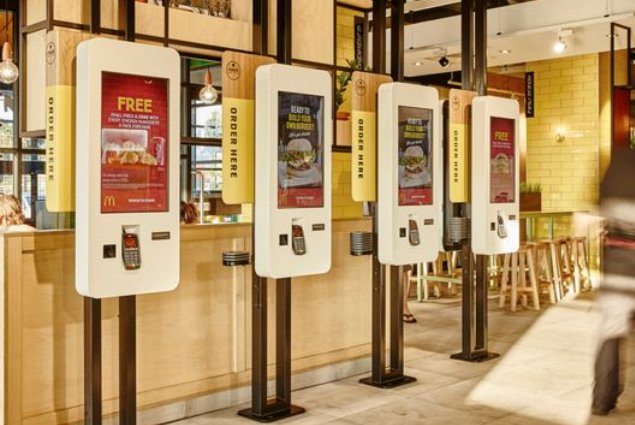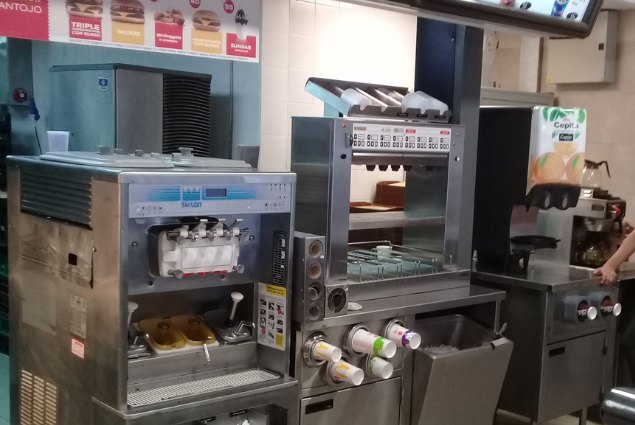McDonald’s quick-service restaurants are one example of how to create an efficient customer flow and a brand-specific space layout. This is a great example to learn from if you are planning to design your own restaurant. It could also be useful for convenience store owners.
This topic could be very relevant for our Display&Stands Market readers. That’s why we are also focusing on this issue in this article.
Let’s explore some interesting details of McDonald’s layout. So that we can understand how it is engineered for speed, efficiency, and customer satisfaction.
The entryway and ordering area
The entryway and ordering area are far more than a mere point of entry; they function as a multi-faceted operational hub that sets the tone for the customer’s entire experience.
McDonald’s designs these zones to fulfill various purposes:
- Guide customer flow
- Promote special deals or new items
- Facilitate efficient ordering
These objectives are achieved through physical layout, visual cues, and technological interfaces.
Zonal design in Mcdonald’s layout

One of the first things to notice is the zonal design of the entryway and ordering area. McDonald’s often divides this area into the queue, ordering counter, and self-service kiosks.
These zones are laid out to minimize bottlenecks and encourage a smooth flow of traffic. They guide the customer naturally from the entrance to the point of order.
Signage and menu boards

Strategically placed signage and menu boards play a crucial role in McDonalds. Even before customers reach the counter, they have a clear view of the menu. It is often displayed on big, easy-to-read boards or digital screens. Not all McDonald’s restaurants have digital screens, but they are gradually being installed in all restaurants.
Digital menu signages not only aids in faster decision-making but also enhances customer experience by reducing uncertainty and wait times. The use of digital menu boards allows for easy updates and the ability to display time-sensitive promotions. McDonald’s displays several MENUs during the day, such as a breakfast offer and a daily offer. Digital screens allow you to automatically change the menu on demand.
This approach, with its dynamic menu, can also be adapted to other types of restaurants. Many restaurants have a daytime business lunch offer, a daily special offer, and other promotions that only run at certain times or on certain days of the week.
Self-service kiosks

McDonald’s has been an early adopter of self-service kiosks. They allow customers to place orders without staff interaction. These kiosks are usually placed near the entry but slightly apart from the main queue to give customers an option to sidestep the traditional line.
These kiosks are equipped with intuitive touchscreen interfaces and often offer customization options that may not be readily available when ordering from staff. They also integrate with payment systems, allowing for a smoothless ordering-to-payment transition.
These kiosks speed up the ordering process and reduce errors. It is a win-win for both the business and the customer.
Digital displays and promotional materials

In many McDonald’s outlets, you’ll find digital displays showcasing current promotions, new items, or even community messages. These are carefully placed to capture attention while people are in the queue. The content is often bright, colorful, and dynamically presented to hold interest and convey information quickly.
Queue management systems
An often-underestimated element is the queue management system. McDonald’s usually employs a single serpentine line that feeds into multiple counters. This approach is considered one of the fairest and most efficient queue systems, preventing the frustration of choosing a ‘slower’ line.
Accessibility
Last but not least, McDonald’s plan the layout with accessibility in mind. Whether it’s the height of counters or the space between self-service kiosks, considerations are made to ensure that all customers, including those with disabilities, have a smooth experience.
By dissecting McDonald’s approach to its entryway and ordering area, retailers can gain critical insights into efficient customer flow management, the strategic use of technology, and the power of visual communication. Therefore, these lessons can be invaluable in any customer-facing industry where efficiency, clarity, and speed are of the essence.
Integrating technology
McDonald’s has long been a beacon of operational efficiency in the fast-food industry. Their adroit technology integration has kept them at the forefront in today’s digital age. Leveraging a range of technologies, from self-service kiosks to sophisticated
Point of Sale (POS) systems offers an in-depth lesson in how technology can streamline operations and improve the customer experience. This section will delve into the specific technologies McDonald’s uses to gain this edge.
Point of Sale (POS) Systems

Behind the counter, staff members interface with advanced POS systems designed for speed and efficiency. These systems often include touchscreen interfaces and are integrated with kitchen display systems (KDS). It ensures that orders are accurately and promptly communicated to the kitchen staff.
Kitchen display systems (KDS)
Once an order is placed, it’s immediately routed to a digital display in the kitchen. It is a vital part of the order preparation process. It lets staff to see the current order and a queue of upcoming orders. This visibility enables better planning and pacing, reducing wait times and increasing efficiency.
Mobile ordering and payment
The McDonald’s mobile app is increasingly essential in the brand’s tech-savvy strategy. Customers can order and pay through the app. Then they can choose to pick up their food via curbside service, the drive-thru, or inside the restaurant.
Mobile app also allows for a more personalized customer experience, as the app can remember past orders and suggest favorites.
Contactless payment options
Alongside traditional payment methods, McDonald’s offers various contactless payment options. For example, Apple Pay and Google Pay. It ensures faster transactions and adds an extra layer of safety, particularly relevant in a post-pandemic world.
Data analytics and inventory management
Behind the scenes, McDonald’s employs sophisticated data analytics and inventory management systems. This data-driven approach aids in understanding customer behavior, predicting peak hours, and managing inventory. All of which contribute to a more efficient operation.
Digital signage for marketing and communication
Beyond menu boards, McDonald’s utilizes other forms of digital signage for promotional or informational purposes. From highlighting community outreach programs to displaying nutritional information. These additional digital displays inform and engage customers as they wait for their meals.
Using technology in McDonald’s operations isn’t merely about keeping up with the times. It’s about continually improving efficiency, reducing error, and enhancing the customer experience. The technologies mentioned above have broad applications. Furthermore, they can serve as inspiration for retail businesses and other customer-facing operations looking to gain a digital edge. Learn more about displays, stands, and signage for fast food restaurants.
Kitchen layout

McDonald’s often hides their kitchen layout from the customers. However, it plays a pivotal role in ensuring that employees process the orders rapidly and accurately.
In a typical McDonald’s kitchen, you’ll find an assembly-line setup. Each station is dedicated to a particular task—grilling, frying, or assembling. This approach minimizes movement and ensures that each employee knows their role, thereby speeding up service.
The kitchen often uses digital displays to keep track of orders and timings. Another nod to the efficiency that technology can bring into fast-paced environments.
The pick-up and dining areas
After ordering, customers are led to the pick-up counters, followed by the dining area. Here, too, the design aims for maximum efficiency.
The pick-up counters are usually adjacent to the ordering area to minimize customer movement. Following that, they arrange the dining area to allow easy cleaning and quick turnover. For example, tables and chairs are often modular and easy to clean. McDonald’s also uses digital signage here to call out order numbers, enabling a smoother pick-up process.
The drive-thru

A significant portion of McDonald’s business comes from drive-thru orders with their own set of operational challenges and requirements.
The drive-thru layout is a masterpiece of logistical planning, from the dual lanes that allow for more orders to the digital menu boards that speed up decision-making. Again, the aim is to minimize a customer’s time from entering the queue to receiving their order.
This fast and efficient service has made McDonald’s drive-thru a case study in operational efficiency.
Conclusion about McDonald’s layout
McDonald’s layout is a design and a well-calculated strategy that places efficiency at its core. The arrangement of the ordering counters, the assembly line style kitchen, the streamlined pick-up and dining areas, and the optimized drive-thru all contribute to a seamless customer experience. Retailers and restaurateurs can draw valuable insights from McDonald’s layout and operational model to improve their businesses.
It is important to note that McDonald’s is making its restaurant design and processes more sustainable. They have a plan to minimize emissions and waste by 2030. There is also a strong focus on resource efficiency.
McDonalds layout images on Pinterest
At DisplayStandsMarket.com, effective layout planning and the intelligent use of digital signage can transform customer experiences across sectors. Understanding the principles of efficient layout design can offer you a competitive edge. Thank you for choosing us as your trusted guide. Stay tuned for more articles that empower your business decisions.
On our Display&Stands Market Pinterest account, we have collected many images related to McDonald’s layout and design. We have used images directly from Pinterest in the display content of this page. To see them all, check out the McDonalds Layout Design board. Explore, get inspired and improve your business brand and efficiency.

